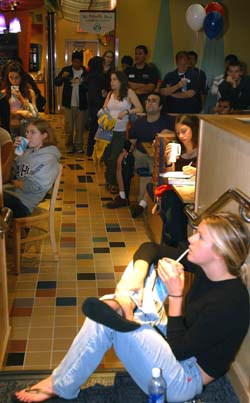When the curtain went up on the presidential debate at the University, only 233 lucky student ticket-holders were in the tightly secured debate hall in the Athletic Complex. So, like millions of viewers worldwide, most students picked a place to watch the debate on television.
Many chose to join friends in the common rooms of their residence halls or at one of the University’s eight remote-viewing sites.

At Edison Theatre, a crowd formed early, waiting for the doors to open at 6:30 p.m. Pre-med students Shikha Wadhwani and Reshi Kanuru, who met in biology lab their sophomore year, chose seats up front.
Looking forward to the debate, Kanuru said, “I want details on health care, foreign policy and other issues. So far the candidates sound like they’re describing a utopia.”
Wadhwani added, “We’re both interested in funding for stem-cell research.”
In a room abuzz with energy and chatter and festooned with red, white and blue balloons and streamers, most students held Kerry signs, and others had ones for Bush. Several read Student Life, while others flipped their cell phones open and snapped images of friends.
Somebody, referring to the jockeying to be in the background of CNN’s live broadcast from Brookings Quadrangle, yelled, “Did you get on today?”
Commenting on her quest to be on CNN, Wadhwani said, “My father has been calling family in India, telling them to watch for me on CNN. I don’t know if they can even get CNN.”
For Wadhwani, Kanuru, sophomore Mary Rosamond and many other students, this election will be the first in which they’ve been eligible to vote. Having a debate at the University has increased their interest in the process.
“I’m leaning toward Bush,” Kanuru said.
“And I’m leaning toward Kerry,” Wadhwani said. “We try not to argue, but it happens. I think each of us hopes the debate will help us sway the other person.”
At Edison, the “pregame show” was a discussion of each campaign’s advertising and ethical issues that such promotion raises. The presentation, “Selling the Presidency,” was sponsored by the University’s Center for the Study of Ethics and Human Values and Student Union.
Between that and the beginning of the main event, there was free pizza.
After the debate, a “Debate the Debate Panel” discussed questions and comments from students.
Meanwhile, in Moore Auditorium on the Medical Campus, the “pre” event was a presentation by Larry J. Shapiro, M.D., executive vice chancellor for medical affairs and dean of the School of Medicine. He explained that the present rate of growth in health-care expense is unsustainable.
“We are on a collision course,” Shapiro said, “and the candidates’ responses to the crisis are quite different.”
In the talk, sponsored by the American Medical Student Association, he explained that Bush focuses on changes to help private insurance work better, whereas Kerry wants to make extensive use of and expand the publicly funded system.
At 8 p.m., the debate began and was broadcast to all the remote sites. An animated crowd watched in Simon Hall, and on the South 40, students gathered in Ursa’s Café in Gregg House, where popcorn and television screens abounded.
Midway through, freshman David Brigati thought Bush had the upper hand. Junior Imani Anwisye thought the debate was somewhat informative, but she said, “They’re repetitive in their attacks on each other.”
Several students felt both candidates performed well and the faceoff ended in a draw. Of course, as a barometer of sorts, one could use the cookie-buying contest being held at Ursa’s and several other campus eateries to see how many cookies emblazoned with donkeys or elephants had been sold. (The tally as of Oct. 11 was 651 donkeys vs. 407 elephants.)
After the debate, students flocked toward Graham Chapel to see Mo Rocca, correspondent for Comedy Central’s The Daily Show With Jon Stewart and author of All the Presidents’ Pets (see related story).
But, for 40 minutes, police officers in full riot gear blocked their passage at Forsyth Boulevard, the route of the candidates’ departing motorcades.
Cheers erupted when flashing lights of the motorcades’ police escorts appeared, and, when the “all clear” was given, students clamored through the tunnel to make Rocca’s performance.
Being at the University as it hosted the debate provided unique and invaluable perspectives on America’s political process, and, for most students, it likely was a once-in-a-lifetime experience.